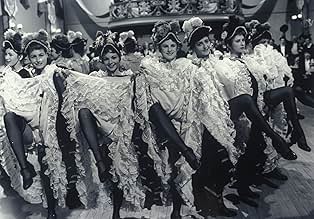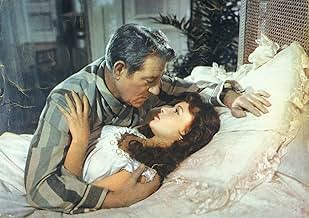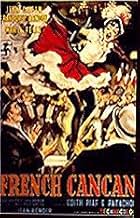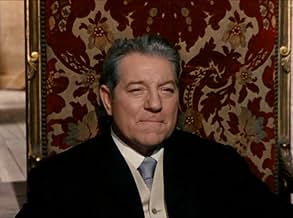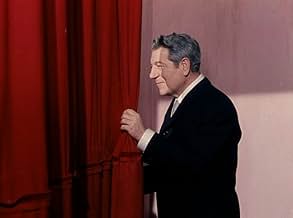ÉVALUATION IMDb
7,3/10
4,7 k
MA NOTE
Cette comédie dramatique de Jean Renoir relate la relance de la danse la plus célèbre de Paris, à travers l'histoire d'un directeur de théâtre qui transforme une humble lavandière en une ved... Tout lireCette comédie dramatique de Jean Renoir relate la relance de la danse la plus célèbre de Paris, à travers l'histoire d'un directeur de théâtre qui transforme une humble lavandière en une vedette du Moulin Rouge.Cette comédie dramatique de Jean Renoir relate la relance de la danse la plus célèbre de Paris, à travers l'histoire d'un directeur de théâtre qui transforme une humble lavandière en une vedette du Moulin Rouge.
Avis en vedette
10bob998
This is my favorite Renoir from the Fifties. It's the story of how Henri Danglard built and launched the Moulin Rouge nightclub; we see the workmen blasting at the site to get construction underway, and the training of the dancers. Finally, the giddiness of opening night and the long sequence of cancan dancing. Financial problems and the ego displays of the performers are described.
Gabin is in great form as the easy-going Danglard--see him deal humorously with Nini's violent boyfriend. Gianni Esposito is moving as the wistful Prince who is courting Nini. Maria Felix, with that amazon's body, is imposing as the egotistical Lola, Danglard's first lover. Finally Françoise Arnoul as Nini the washing girl who ends up dancing for Danglard, and becoming his girl, is just stunning; her loveliness and pert charm will win you over.
A bonus: we get Edith Piaf, Patachou, André Claveau and other stars in cameos playing the stars of a century ago who ruled over the Moulin rouge.
Gabin is in great form as the easy-going Danglard--see him deal humorously with Nini's violent boyfriend. Gianni Esposito is moving as the wistful Prince who is courting Nini. Maria Felix, with that amazon's body, is imposing as the egotistical Lola, Danglard's first lover. Finally Françoise Arnoul as Nini the washing girl who ends up dancing for Danglard, and becoming his girl, is just stunning; her loveliness and pert charm will win you over.
A bonus: we get Edith Piaf, Patachou, André Claveau and other stars in cameos playing the stars of a century ago who ruled over the Moulin rouge.
"French Cancan" is one of my favorite all time movies. It's an excellent film. There's color, there's humor, there's music. It's a very good portrait of the so called Belle Époque, though Jean Renoir's priorities were always to show a creation, a fantasie. So the film isn't a historical movie. The final sequences in which the girls dance cancan are unforgettable images. It's a film you shouldn't miss.
Portrait of a time. portrait of a legend. seductive for the genius of Jean Renoir. and for the inspired performances. and, sure, for the nostalgia of the viewer. an admirable Jean Gabin and a great embroidery of love stories, show world, rivalries and triumph. optimistic, romantic. and refreshing. and that does to it a special status. like refuge, splendid show, fairy tale and confession of a lost age.
The story is simple but the execution is marvelous. A Belle Epoque impresario, down on his financial luck, is going to open a new club, the Moulin Rouge, with a new dance, the French cancan. He encounters a working girl and makes her a dancer. She'll become a star. There are several crises to overcome before that happens.
The movie is Jean Renoir's tribute to show business, and he puts it on the screen with color, verve, humor, and humanity. There are wonderful performances by all the actors. The leads are Jean Gabin as Henri Danglard, the impresario; Francoise Arnoul as Nini, the girl who'll become a star; and Maria Felix as Lola de Castro, an overwhelmingly tempestuous beauty and Danglard's lover at the start. Gabin exudes confidence, worldly humor and dedication to show business. He even dances a bit. Arnoul is first rate, too. It looks like she was doing her own dances, and as an actress think of a young Leslie Caron with brains and charm.
The climax of the movie is the opening of the club, with Felix's star dance, comic songs, a whistler, a Danglar-discovered singer, all moving toward the introduction of the French cancan. The crises happen and are resolved. Then the cancan explodes. Dancing girls come bursting out from the stage, the front of the theater, through posters, down ropes from the balcony. The house swirls with the black tie and tails of the swells and the garish colors of the dancers' gowns. The cancan number lasts probably ten or fifteen minutes or so, all music and gaiety, all high kicks and splits. It's amazing when row after row of the dancers, moving toward the camera through the audience, leap up, legs extended straight forward and backward, backs arched, then land on the dance floor in full splits. I didn't know whether to shout or wince.
The last scene of the movie is outside the club, shot from the cobblestone street looking at the entrance. It's a medium shot and from the side street a happy, inebriated fellow in black tie and top hat staggers across, pauses to tip his hat at the camera, then staggers off. A completely charming ending.
This really is a marvelous movie.
The movie is Jean Renoir's tribute to show business, and he puts it on the screen with color, verve, humor, and humanity. There are wonderful performances by all the actors. The leads are Jean Gabin as Henri Danglard, the impresario; Francoise Arnoul as Nini, the girl who'll become a star; and Maria Felix as Lola de Castro, an overwhelmingly tempestuous beauty and Danglard's lover at the start. Gabin exudes confidence, worldly humor and dedication to show business. He even dances a bit. Arnoul is first rate, too. It looks like she was doing her own dances, and as an actress think of a young Leslie Caron with brains and charm.
The climax of the movie is the opening of the club, with Felix's star dance, comic songs, a whistler, a Danglar-discovered singer, all moving toward the introduction of the French cancan. The crises happen and are resolved. Then the cancan explodes. Dancing girls come bursting out from the stage, the front of the theater, through posters, down ropes from the balcony. The house swirls with the black tie and tails of the swells and the garish colors of the dancers' gowns. The cancan number lasts probably ten or fifteen minutes or so, all music and gaiety, all high kicks and splits. It's amazing when row after row of the dancers, moving toward the camera through the audience, leap up, legs extended straight forward and backward, backs arched, then land on the dance floor in full splits. I didn't know whether to shout or wince.
The last scene of the movie is outside the club, shot from the cobblestone street looking at the entrance. It's a medium shot and from the side street a happy, inebriated fellow in black tie and top hat staggers across, pauses to tip his hat at the camera, then staggers off. A completely charming ending.
This really is a marvelous movie.
Of the several Jean Renoir films I have seen, this was by far the most interesting.
This film was obviously the inspiration for the Baz Luhrman film Moulin Rouge. Luhrman even appropriated one of the original songs for use in his film.
The film tells the story of the construction of the Moulin Rouge for the presentation of a revival of the CanCan. Although characterization is a bit weak and most characters are little more than stereotypes, the plot, music, action, and spectacular visuals more than make up for the shortcomings.
This is a loving tribute to the Paris of the impressionist period and is filmed beautifully in color.
Does anyone know if there is any truth to the tale?
This film was obviously the inspiration for the Baz Luhrman film Moulin Rouge. Luhrman even appropriated one of the original songs for use in his film.
The film tells the story of the construction of the Moulin Rouge for the presentation of a revival of the CanCan. Although characterization is a bit weak and most characters are little more than stereotypes, the plot, music, action, and spectacular visuals more than make up for the shortcomings.
This is a loving tribute to the Paris of the impressionist period and is filmed beautifully in color.
Does anyone know if there is any truth to the tale?
Le saviez-vous
- AnecdotesThe on-screen singer of "La complainte de la Butte" is not Cora Vaucaire (credited in the titles) as she was deemed not good-looking enough to appear on film, so Italian actress Anna Amendola was put in front of the camera and mimed to the song...
- Citations
Henri Danglard: Do I look like Prince Charming? Only one thing matters to me - what I create.
- Autres versionsOriginally released in the US in 1956 at 93 minutes; ten minutes of footage removed from the original French version were reinstated for 1985 reissue.
- ConnexionsFeatured in Voyage à travers le cinéma français (2016)
Meilleurs choix
Connectez-vous pour évaluer et surveiller les recommandations personnalisées
- How long is French Cancan?Propulsé par Alexa
Détails
Box-office
- Brut – à l'échelle mondiale
- 10 799 $ US
- Durée1 heure 42 minutes
- Couleur
Contribuer à cette page
Suggérer une modification ou ajouter du contenu manquant

Lacune principale
By what name was French Cancan (1955) officially released in India in English?
Répondre
![Regarder Bande-annonce [VO]](https://m.media-amazon.com/images/M/MV5BMDIzNTViZDUtMTQ0MC00MDExLWFkNzYtNjJhMDlkN2YzMDRjXkEyXkFqcGdeQXRyYW5zY29kZS13b3JrZmxvdw@@._V1_QL75_UX500_CR0)
